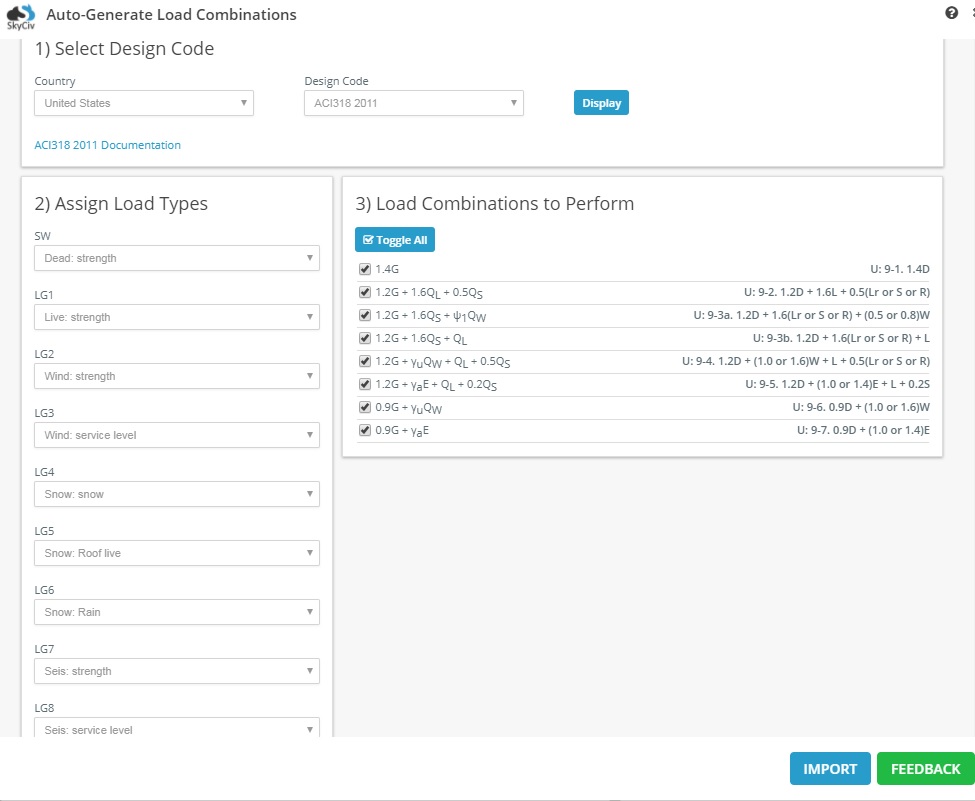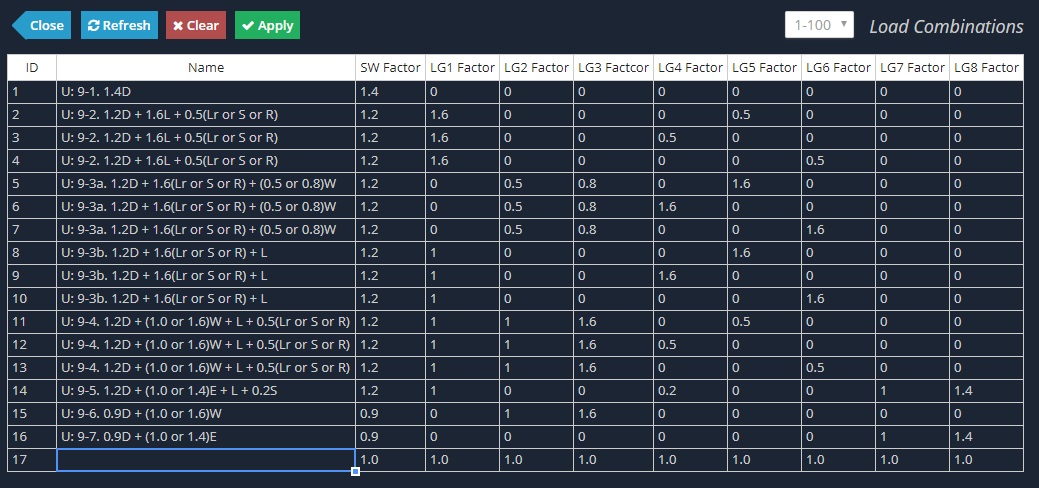A guide to Load Combinations for ACI 318-11 and ACI 318-19
In the United States, ACI 318-11 covers the materials, design, and construction of structural concrete used in buildings and applicable nonbuilding structures. It also covers the evaluation of strength for concrete structures that already exist.
Chapter 9 of the code details the strength and serviceability requirements of structural members. Fundamentally, all structures/structural members should possess design strengths at all sections at least equal to the required strengths calculated for the factored loads and forces in combinations.
Required strength (U) shall be at least equal to the effects of factored loads in equations 9-1 through 9-7.
This article will focus on how SkyCiv’s auto-generated load combinations feature meets the load combination equations as specified in ACI 318-11.
9.2.1 Required Strength
| Design Code Equation | Design Code Comment | SkyCiv Equation | SkyCiv Comment |
|---|---|---|---|
| U = 1.4D | Eq. 9-1 | 1.4G | – |
| U = 1.2D + 1.6L + 0.5(Lr or S or R) | Eq. 9-2 | 1.2G + 1.6QL + 0.5QS | The load type QS “Snow” is sub-categorized into “snow”, “roof live”, and “rain”. Selecting this load combination will automatically create 3 load combination equations due to the use of “or” in the combination. |
| U = 1.2D + 1.6(Lr or S or R) + (1.0L or 0.5W or 0.8W) | Eq. 9-3. Referencing R9.2-Required Strength (b): Where W is based on service-level wind loads, 0.8W shall be used in place of 0.5W in Eq. 9-3. | 1.2G + 1.6QS + ψ1QW 1.2G + 1.6QS + QL |
This load combination involves 3 terms. As in the combination for Eq. 9-2, QS will create 3 equations to account for the “or” statement for “snow”, “roof live”, and “rain”.
The third term is either L (live) or W (wind). SkyCiv represents this by 2 separate load combinations (each generating 3 equations). To account for service level requirements in R9.2(b), users can select load types “Wind: strength” or “Wind: service level” to apply factors 0.5 or 0.8 (respectively) to their load groups. |
| U = 1.2D + (1.0 or 1.6)W + 1.0L + 0.5(Lr or S or R) | Eq. 9-4. Referencing R9.2-Required Strength (b): Where W is based on service-level wind loads, 1.6W shall be used in place of 1.0W in Eq. 9-4. | 1.2G + γuQW + QL + 0.5QS | This load combination involves 4 terms. As in the combination for Eq. 9-2, QS will create 3 equations to account for the “or” statement for “snow”, “roof live”, and “rain”.
The second term for W (wind) has two possible factors. To account for service level requirements in R9.2(b), users can select load types “Wind: strength” or “Wind: service level” to apply factors 1.0 or 1.6 (respectively) to their load groups. |
| U = 1.2D + (1.0 or 1.4)E + 1.0L + 0.2S | Eq. 9-5. Referencing R9.2-Required Strength (c): Where E is based on service-level forces, 1.4E shall be used in place of 1.0E in Eq. 9-5. | 1.2G + γaE + QL + 0.2QS | This load combination involves 4 terms. As “snow” is explicitly mentioned in the combination, QS will only generate one equation.
The second term for E (seismic) has two possible factors. To account for service level requirements in R9.2(c), users can select load types “Seis: strength” or “Seis: service level” to apply factors 1.0 or 1.4 (respectively) to their load groups. |
| U = 0.9D + (1.0 or 1.6)W | Eq. 9-6. Referencing R9.2-Required Strength (b): Where W is based on service-level wind loads, 1.6W shall be used in place of 1.0W in Eq. 9-6. | 0.9G + γuQW | This load combination involves 2 terms. Only 1 equation is generated.
The second term for W (wind) has two possible factors. To account for service level requirements in R9.2(b), users can select load types “Wind: strength” or “Wind: service level” to apply factors 1.0 or 1.6 (respectively) to their load groups. |
| U = 0.9D + (1.0 or 1.4)E | Eq. 9-7. Referencing R9.2-Required Strength (c): Where E is based on service-level forces, 1.4E shall be used in place of 1.0E in Eq. 9-7. | 0.9G + γaE | This load combination involves 2 terms. Only 1 equation is generated.
The second term for E (seismic) has two possible factors. To account for service level requirements in R9.2(c), users can select load types “Seis: strength” or “Seis: service level” to apply factors 1.0 or 1.4 (respectively) to their load groups. |
Software Example: All Load Types Assigned
Whilst not practical, 9 load groups have been created and assigned to all 9 load types as seen below. This is done to check the equations that are formed from the ACI 318 load combinations


Other ACI 318-11 and ACI 318-19 Resources
SkyCiv has compiled a long list of articles and resources for ACI 318 Concrete Design. Our software supports ACI 318 Design Checks for RC Beam and Column Design, Slab Design, Base Plate Design and Pile/Isolated Foundations – so whatever part of the structure you need to design, we have it! Here are some other related articles which might help:
- Combined Footing Design in Accordance with ACI 318-14
- Isolated Footing Design Example in Accordance with ACI 318-14
- ACI 318 Concrete Pile Design Example
- ACI 318 Slab Design Software
- ACI 318 Base Plate Design Software
- ACI 318 Beam and Column Design Software
ACI 318 is an important design standard for the US and many other countries. We are happy to support this design standard to support structural engineering across the globe.

